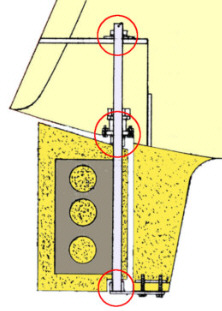Caliber 40s also boast a "double-bottom effect" created by integral tanks in the bottom of the hull. "If you were to hole the hull in these areas," says McCreary, "water would be contained in the tanks. It’s like an oil-tanker’s double hull, but instead of keeping oil out of the ocean, we’re trying to keep the ocean out of our boats."
Rudder & shaft rated an average score over 9.2, which probably can be attributed to Caliber’s Triple-Support Rudder System, which distributes the rudder’s load between three bearings--at the top of the 2" dia. s.s. shaft, at the bronze rudder port, and at the rudder shoe. Exterior stainless and trim averaged 9s, deck hardware averaged just over 8, thru-hull fittings received an average score of 8, and steering system received 7s and 8s.
Passagemaking/Performance
While many Caliber 40s have routinely logged ocean passages, including several transatlantics, and one is in the midst of a circumnavigation, none of the survey respondents had extensive offshore experience with the 40LRC. However, all had at least ventured overnight with their Calibers. More importantly, however, all had great plans for their Calibers’ blue water futures, which should be exceeding bright, for this boat has been created with voyaging in mind.
First, the difference between the Caliber 40 and the Caliber 40LRC. "The major difference between the Forty and the Forty LRC is tankage," George McCreary told us. And what a difference! While the original 40 had 55-gal. and 156-gal. fuel and water capacities respectively, the 40LRC boasts 212 gals. of fuel and 179 gals. of water. This is a significant upgrade for those with extended cruises in their futures. Both figures are awesome. The 212 gals. fuel capacity provides an estimated range of 1,484 miles with the standard 50-h.p.
 The triple-support rudder system. Provides three attachment points for
increased strength.
The triple-support rudder system. Provides three attachment points for
increased strength.
diesel; the 179-gal. water capacity preempts the need for a water-maker.
As a practical matter, 212 gallons of fuel allows the skipper to buy
duty-free fuel when available, instead of having to buy it at premium
prices when needed. For most long-range cruisers, this volume amounts to
a six-month supply, which provides a comfortable margin of safety.
With a hefty displacement
of 21,600 lbs. on a 32’6" waterline and a Displacement/Length Ratio
(D/L) of 281, the 40LRC is moderately heavy by modern cruising boat
standards; a Valiant 40 has D/L of 256; a Sabre 38, 224; a J/40, 176.
But a modern underbelly with cut-away sections fore and aft of the keel
presents minimal wetted surface, and high-lift, low-drag keel-foil
sections improve performance. The relatively high D/L suggests to us
that this boat will move easily with a kindly motion in a seaway while
carrying a long-term voyaging payload. Scores of 8 were given to roll
factor and sea motion. Survey respondents gave scores of 8 for "sea
motion" and "dry decks." With dodgers installed, scores for cockpit
protection averaged 8.5
The Sail
Area/Displacement Ratio (SA/D) of 15.3 is low by today’s standards (the
Sabre 38 has an SA/D of 17.9; the J/40, 20.2), but the venerable Valiant
40 has a